Beyond the save point, Samus reaches the lab proper. Technically, I suppose the whole space station is a lab, but it’s divided into quarantined simulation zones and work zones for the scientific support. This area is the latter.
And here you find another Super Metroid parallel: Samus arrives too late to this lab to prevent its civilian personnel from suffering a terrible fate. As at Ceres Station, bodies lay strewn across the ground, the collateral of whatever violent horror has taken place here.
In this case, though, not all the bodies simply lie dead. Beyond the human corpse is a bizarre zombie that rises from a degenerate puddle — a human possessed by an X parasite, evidently. The leftmost corpse never stirs, suggesting that this civilian was killed by a parasite-possessed colleague before he or she could be consumed by an X.
The zombie doesn’t pose much of a threat, ranking somewhere below “Castlevania zombie” on the danger meter. It just shuffles along, quivering slightly if Samus comes within striking range.
Unlike the small creatures Samus has already encountered at this point, though, the zombie doesn’t disintegrate when “killed.” It disgorges an X, yes, and you can soak up the parasite per usual. But the zombie itself collapses into a wobbly puddle of goo that you can’t interact with. If you leave the X it emits alone, the parasite will eventually return to the zombie’s mass, regenerating into an upright monster again. All you can do here is prevent the X from reconstituting its host. This is not a common scenario throughout the game, but reformation of enemies is something you’ll have to deal with from time to time and this is a nice, safe introduction to the mechanic.
Above the first zombie lurks another, as well as a more curious obstacle: Some sort of mucus-like growth obstructing a door. Your blaster can’t harm this thing, so it basically represents another obstacle to overcome in the future — one to file mentally alongside red and green doors.
Surprise! You quickly arrive at another Navigation Room. As you can see, the station is lousy with them. This time, Adam passes along information on a superficial change to the game mechanics from previous chapters of the series: How Samus acquires gear. In other games, you almost always collected power-ups from ancient Chozo statues… but since Fusion takes place in a human-built space station rather than the ruins of a Chozo-colonized planet, there are none of those statues on hand. Instead, Samus is forced to rely on the Federation to pass along weapons data for her new suit as they’re able to develop it— the idea that Samus’ powers here are simulations of her previous skills developed for her new bio-technical suit. A little flimsy as premises go, but sure.
There’s a feeling of tension and urgency in the background of Fusion, and it comes in part from the looming sensation that you were rushed into action before Samus was fully ready. The Federation works in the background to come up with programs to allow her gear to mimic the functions of the Power Suit. You don’t have certain abilities because those abilities simply don’t exist yet. Again, it’s a thoughtful way to unite play mechanics and story design, and shows that the Fusion team wasn’t simply content to lazily reprise previous games where it didn’t make sense. Structurally, Fusion works quite a bit like its predecessors, but some careful consideration was given to how its workings reveal themselves.
And here’s an entirely different kind of obstacle than ever before: Some sort of structural damage to a pair of conduits. You’ll have to come back once you acquire wire cutters, it seems. Really big honkin’ wire cutters.
The only other door in the area takes you to, yes, an elevator. As in previous games, the elevator serves as a natural break in the layout of the game world…
…but it also serves as an opportunity for exposition. We get a glimpse of Samus’ rich inner life here, whether we want it or not. Later in the game, elevators serve a different narrative function, too. But due to the “down time” they create, elevators make a smart place to advance the story a step or two.
The observation deck basically works as a command center for the station, consisting of a single large chamber leading to one of every kind of sub-room: Navigation, Save, Recharge, and most importantly (for the moment) Data.
It also features this suspicious panel on the wall, but for the moment that’s simply an incidental detail.
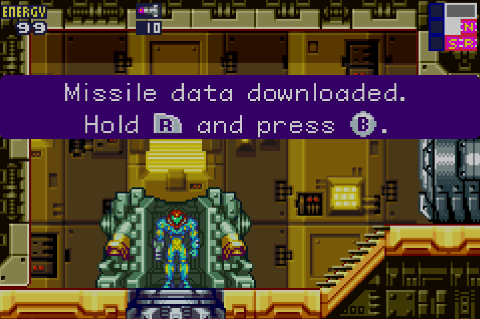
There’s nothing to do here but head to the Data room and upgrade Samus’ suit to fire missiles. Missiles work differently here than in previous games: Rather than activating them with an on/off toggle that brings up missiles in place of standard energy projectiles, you hold down the right shoulder button to work as a modifier. It’s not a bad idea, as mechanics go, allowing you to hot-swap between your weapon selections almost instantly. But it does come with a tradeoff, as the ability to fire at 45 degrees sits solely on the L trigger now. Where in Super Metroid up and down angles were mapped to separate buttons, here you have to hold L then press down to depress Samus’ aim to 45 degrees downward. This is especially cumbersome when you’re firing missiles at a downward angle, as it requires you to hold both shoulder buttons and down and press fire. Blame Nintendo’s goofy decision to make Game Boy Advance functionally a portable Super NES but remove two of the Super NES’s face buttons.
You’re immediately given a new objective here, even as the space station suffers a power loss.
The power outage takes out the doors, so that out-of-place wall hatch comes into play. The room’s illumination dims down, allowing the lighting inside the service tunnels behind the hatch to stand out and draw your attention. As always, Metroid Fusion follows up the acquisition of a new tool or weapon with a situation in which you’re forced to use that tool to get back into the action. But instead of simply sending you through a red door, the game instead makes you find a less-obvious alternate route for advancement. This is a really nice bit of design here, as much of Fusion involves finding hidden routes and passages (including the cathartic “breakout” sequence many hours in). By immediately forcing players to jump through a small and obvious hoop, Fusion sets up player expectations and habits for the future.
Another of those mucus barriers appears here, though this time it completely obstructs your path. With no where to go but forward, you can easily make the mental connection here that you need to blast this thing with missiles to advance.
Further on, a “dead end” allows you to advance with crumbling flooring that regenerates once you pass through it. This pitfalls will come in to play over and over in Fusion, and here you’re getting a crash course.
And finally, you land in a pit which can only be escaped by climbing a ladder embedded in a wall. Oh, the humanity! Samus reduced to climbing a ladder rather than jumping to escape? This gets back to the theme of disempowerment that permeates Fusion: Samus has been weakened, almost crippled, by the X’s attack.
I mentioned her hunched postures in the previous update, but I forgot to point out a major element of her new design that speaks to her newfound weakness. In previous Metroid games, Samus didn’t just stand upright, she held her weapon differently. In the original Metroid, she held it at chest height. Beginning with Metroid II, she began to sling the weapon a bit lower, placing her left (off) hand on top of the gun barrel as if to steady her aim and against the weapon’s kickback. This made even more sense in Super Metroid, where the ability to fire at 45-degree angles made it look even more as though Samus was simply holding her aim steady. But in Fusion, her firing stance changes. Can you spot the difference?
Rather than holding her arm cannon down, now she’s holding it up. Either her body or her suit has been weakened enough that her blaster has become a burden, and she’s forced to support it with her off hand rather than simply steady it. It’s a subtle change, but a significant one. And not incidental, either, because these sprites were deliberately drawn in this fashion — as someone noted in the comments, Samus’ appearance in her Power Suit during the prologue shows her fighting the old way, and the SA-X also walks and shoots with the gait and stance of old Samus. Over and over again, Fusion hammers this theme home: Samus is no longer the invincible loner, and she’s in over her head.
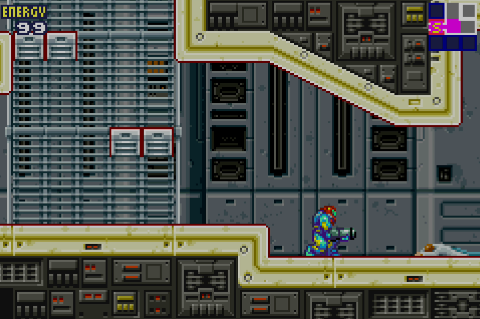
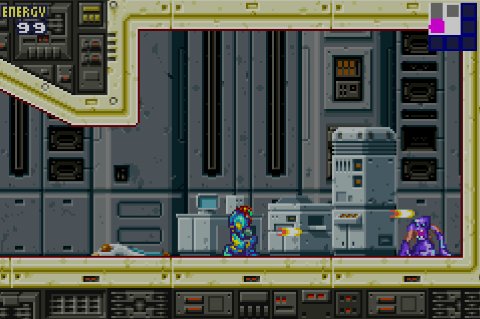
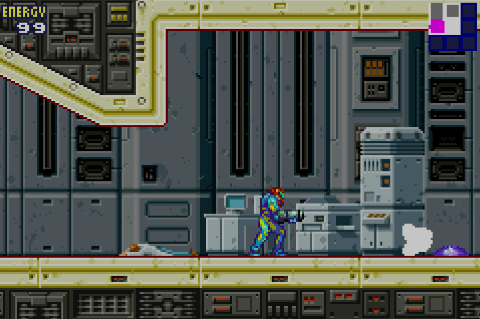
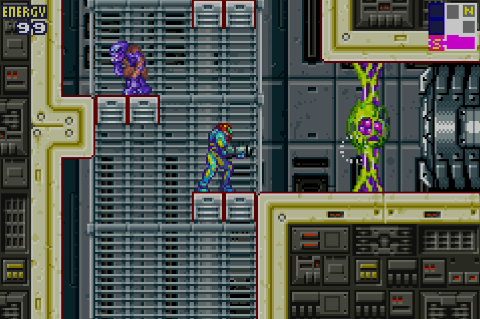
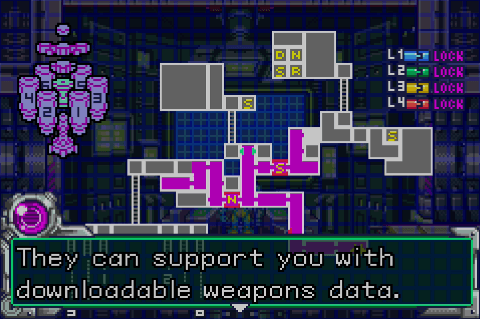
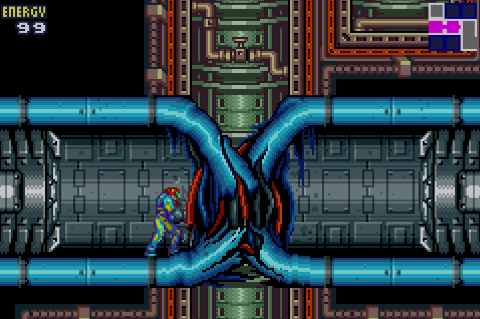
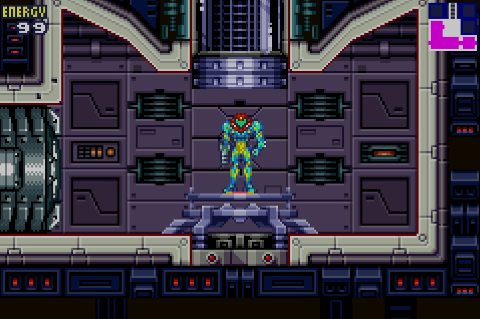
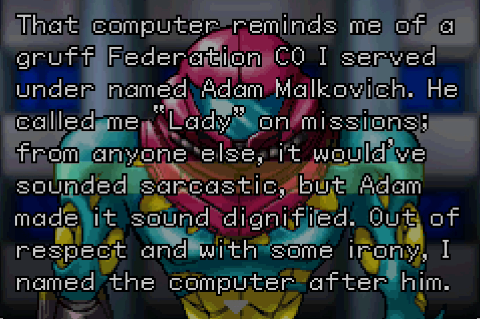
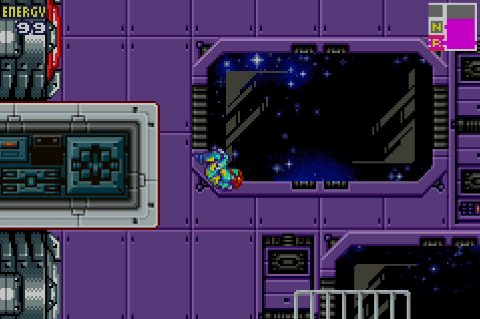
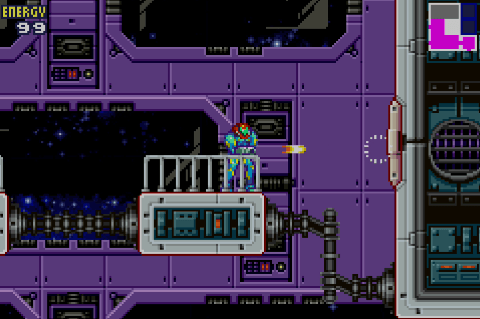
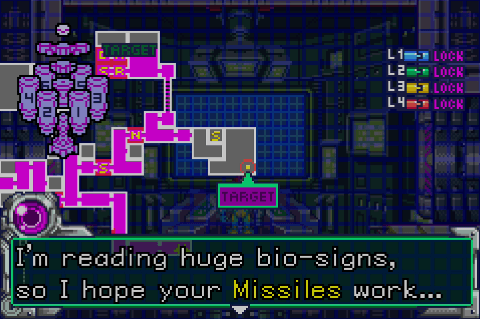
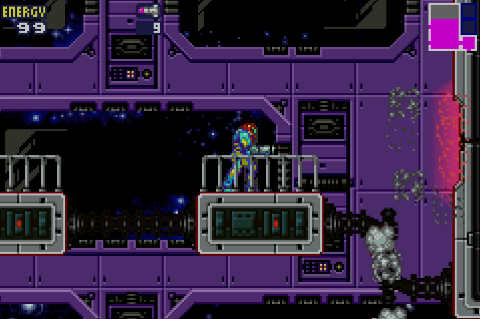
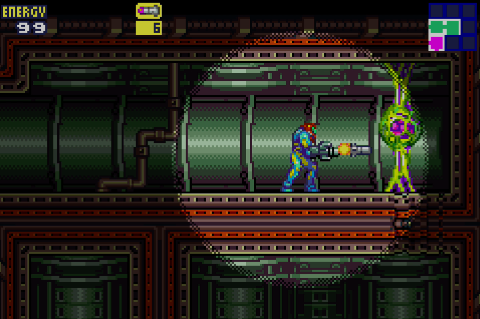
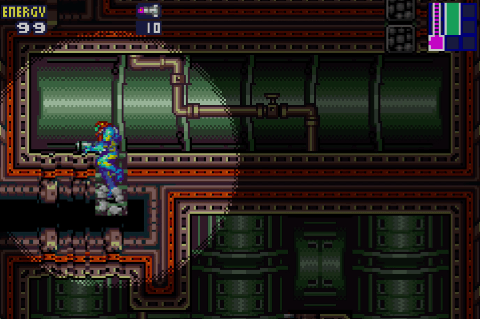
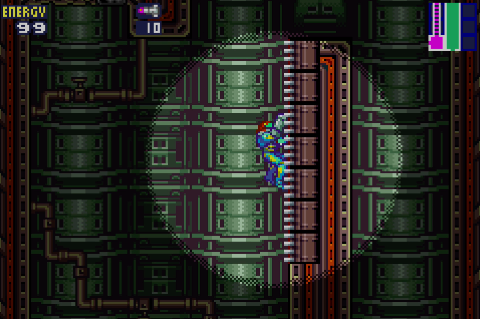
I know it’s popular to hate on this game, but… I hate this game. I just came off a long-needed Metroid vision quest where I played Super Metroid and Zero Mission, each for the first time. Again, I know it’s trite; but I was unprepared for how basically flawless Super Metroid is. Zero Mission is good (I played the original Metroid a long time ago) and I like the new gameplay elements; though I didn’t really like the sections that were distinctly added as much as the parts that were simply altered.
But Metroid Fusion, the last of the 2D Metroids I haven’t played, is constantly annoying me at every turn. I hate how Adam locks doors behind you so you can’t finish exploring the last area. I hate how the world is broken up into different (numbered!) levels by a literal bank of elevators. I hate how Samus pontificates in the elevator shafts. I hate how all the doors are just color-coded security unlocks that are granted to you at pre-authored points in the narrative. I hate how monsters respawn if you don’t catch the X in time (or, sometimes, even if you do overlap the X sprite, but the game just decides you’re going to fight that space pirate again for some reason).
The SA-X is cool, and the gameplay has a good heaviness to it that is also present in Zero Mission and Other M; but Fusion is evidence that the atmospheric, narrative, and conceptual changes criticized in Other M are deliberate, not accidental.
I agree with this. At least Other M had amazing graphics and unique gameplay. I enjoy the game enough despite its storytelling and forced linearity because there are some great action moments and some genuinely insane enemies on hard mode. But Fusion is basically like a weaker version of Super Metroid.
Ultimately, if Nintendo wants to have more story elements in its games, it needs to hire a real writer. Not just have a game designer jot down a few plot points, but actually get somebody who knows about storytelling. That’s something many other major game studios have done, but Nintendo seems to think it’s beneath them.
Wow, praising Other M over Fusion? Now I’ve seen everything.
I used to be annoyed at the way the sectors were laid out in the elevator zone, but having recently replayed it, I have enjoyed how they connect via “secret” areas. I would have liked a bit more prominence on such (like having actual secret rooms where they can connect later in the game), but narratively it was enjoyable when you droped at the tropical sector again.
I was surprised you ended this post before dealing with… the rolling ball guy (the one from metroid 2 who looks like old kraid), but I wouldnt be surprised you are saving him to talk about bosses (like how plenty of them seem to trap/ambush you via that crumbling trap floor and such and they are more gamey and sophisticated than those in SM).
Your sprite comparison made me realize samus seems to have invisible high heels on her Power Suit boots. That foot stance doesnt seem very comfortable, so I guess thats the reason she dropped it somewhat in fusion.
One of my favourite elements in this game is how all the sectors connect in a loop through secret passages at the very end.
On the foot stance, I think that’s mostly just her back heel naturally coming up as she puts weight on the other foot - exaggerated a bit by shading. But you’re right that she’s much more flat-footed in Fusion, in keeping with her lowered overall bearing.
I dunno, your reasoning seems sound for her Metroid 1 sprite. There is already a 1 pixel inclination on what would be her resting/support foot on Metroid 2 already and by Super Metroid she is barely touching the ground.
The justification for slowly doling out powerups is a bit flimsy, but I appreciate they came up with some reasoning behind it. It’s certainly better than “I know you have a suit full of weapons and upgrades but you can’t use them because I told you so”.
I don’t know why, but this makes me want an MGS2 style Metroid game, where you’re a lone military dude with no power suit, constantly having to watch Samus come in and do a bunch of cool stuff that you can’t do yet.
And it ends with you dying just outside the door to Kraid’s lair on Zebes?
I think you end up getting left behind during the inevitable self-destruct sequence.